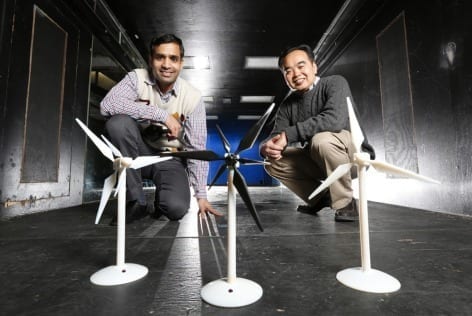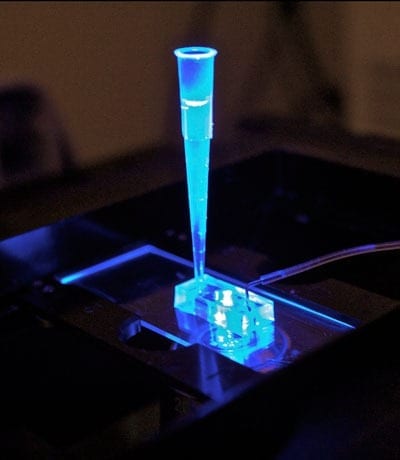
Hui Hu picked up a 3-D printed model of a typical wind turbine and began explaining two problems with the big, tall, three-bladed machines.
First, said the Iowa State University professor of aerospace engineering, check out the base of each blade. They’re big, round structural pieces. They’re not shaped like an airfoil. And so they don’t harvest any wind, reducing a turbine’s energy harvest by about 5 percent.
Second, the big blades disturb the wind, creating a wake behind them and reducing the energy harvest of any downwind turbines. Hu said a turbine sitting in the slipstream of another can lose 8 to 40 percent of its energy production, depending on conditions.
Those losses prompted Hu and Anupam Sharma, an Iowa State assistant professor of aerospace engineering, to look for a solution. Their data suggest they’ve found one.
Hu turned back to his wind turbine models: Look at these two, he said. See what we’ve done?
What they’ve done is add a smaller, secondary rotor. One model had three big blades and three mini-blades sprouting from the same hub. The other had a small, secondary rotor mounted in front of the big rotor, the two sets of blades separated by the nacelle that houses the generating machinery on top of the tower.
“To try to solve these problems, we put a small rotor on the turbine,” Hu said. “And we found that with two rotors on the same tower, you get more energy.”
Using lab tests and computer simulations, Hui and Sharma have found those extra blades can increase a wind farm’s energy harvest by 18 percent.
“These are fairly mature technologies we’re talking about – a 10 to 20 percent increase is a large change,” Sharma said.
Read more: Iowa State engineers study the benefits of adding a second, smaller rotor to wind turbines
The Latest on: Wind turbines
[google_news title=”” keyword=”Wind turbines” num_posts=”10″ blurb_length=”0″ show_thumb=”left”]
via Google News
The Latest on: Wind turbines
- Researchers design highly efficient wind turbine mimicking bird wings: 'This bio-inspired design can increase the power output'on May 1, 2024 at 9:00 pm
This is one of many breakthroughs in wind power. Researchers design highly efficient wind turbine mimicking bird wings: 'This bio-inspired design can increase the power output' first appeared on The ...
- Petitioners hope to block wind turbines in Douglas Countyon May 1, 2024 at 8:35 pm
You'll see wind turbines driving across certain rural parts of Kansas and Missouri. But they could be coming closer to the Kansas City metro ...
- Energy Transitions Commission (ETC) Urges Government and Industry Collaboration to Overcome Perceptions of Offshore Wind Energy 'in Crisis'on May 1, 2024 at 4:01 pm
The latest insights briefing from the Energy Transitions Commission, Overcoming Turbulence in the Offshore Wind Sector, highlights the need for governments and the offshore wind industry to join ...
- Construction of Dominion Energy's Coastal Virginia Offshore Wind (CVOW) Project Has Not Been Delayedon May 1, 2024 at 3:34 pm
Dominion Energy, Inc. (NYSE: D), today announced that any reports that the Coastal Virginia Offshore Wind (CVOW) project has been delayed are false and grossly misrepresent the facts.
- California lawmakers call for $1 billion ‘down payment’ on offshore wind energy infrastructureon May 1, 2024 at 12:56 pm
Lawmakers are calling for including the $1 billion as part of a larger climate bond which may go before voters in November.
- U.S. Saw Drop in Wind Power Last Year, Despite New Turbineson May 1, 2024 at 7:08 am
For the first time since the mid-1990s, U.S. wind generation dropped in 2023, according to government figures. The slump is the result of weak winds in the Midwest, and it comes despite the continued ...
- China Dominated the Global Wind Turbine Market in 2023on May 1, 2024 at 4:02 am
China’s dominance in the wind turbine market has been highlighted in a recent report that shows the country accounting for 65% of new wind capacity last year.
- America’s wind power production drops for the first time in 25 yearson April 30, 2024 at 7:46 pm
U.S. wind power slipped last year for the first time in a quarter-century due to weaker-than-normal Midwest breezes, underscoring the challenge of integrating volatile renewable energy sources into ...
- Wind energy industry produced less power in 2023, despite having increased total generation capacityon April 30, 2024 at 9:24 am
The wind industry produce 2.1% less electricity in 2023 compared to the previous year. Total wind capacity in the U.S. has tripled from 47 gigawatts in 2010 to 147.5 gigawatts by the end of 2023.
- How skyscrapers and wind turbines affect the weatheron April 29, 2024 at 10:05 am
Not only do these buildings channel some stronger wind speeds, but they can also create their own clouds, too! This is done through a process known as orographic lifting. Essentially, cool ...
via Bing News










